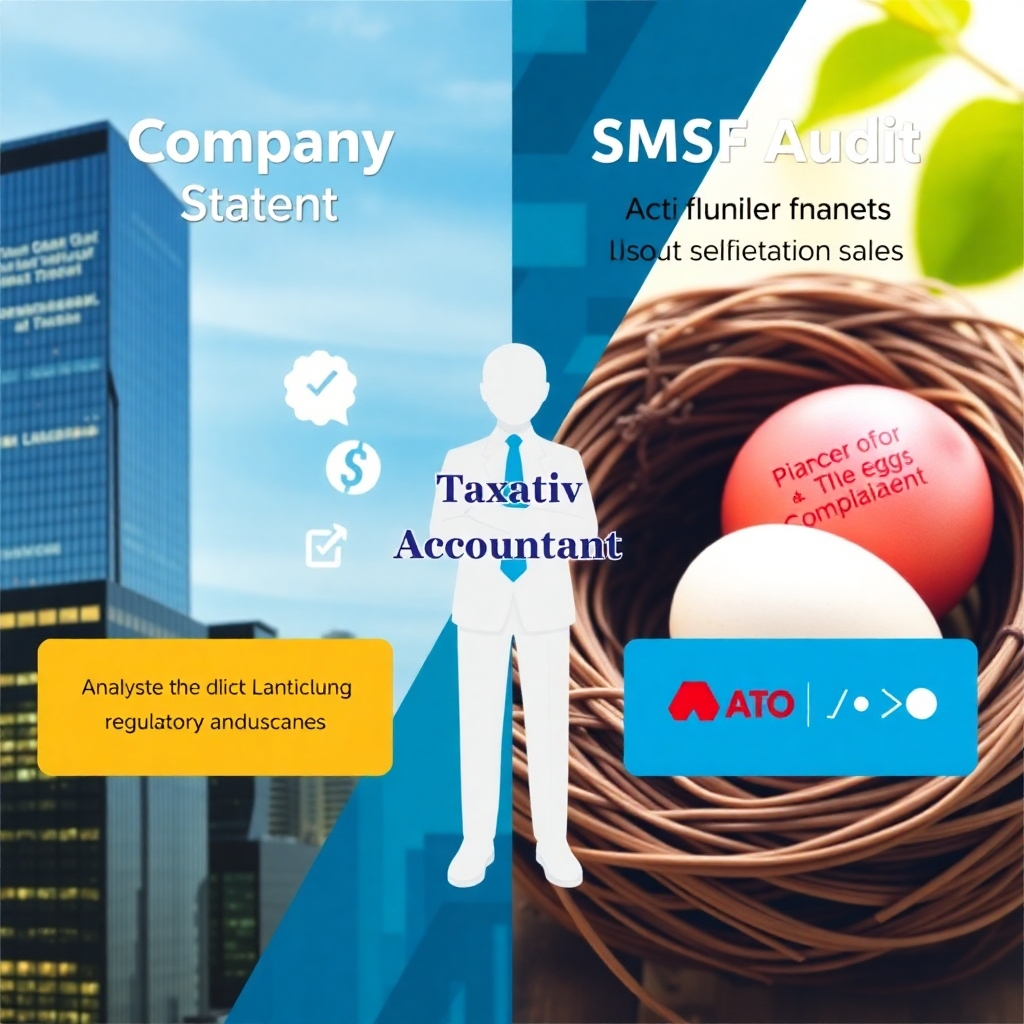
Navigating Company Audits & SMSF Audits
A Taxation Accountant's Perspective (Australia 2025)
Audits are an inherent part of the financial landscape for many Australian entities. For taxation accountants, they represent critical checkpoints demanding meticulous preparation, thorough understanding of regulations, and effective client management. While both company audits and Self-Managed Super Fund (SMSF) audits involve independent scrutiny, they stem from different legislative frameworks, serve distinct purposes, and carry unique implications. From a taxation accountant's viewpoint, navigating these audits effectively requires a nuanced approach, anticipating challenges, and leveraging insights to ensure client compliance and financial integrity, particularly as we look towards the regulatory environment of 2025.
The Taxation Accountant's Role: More Than Just Numbers
By Robert White

Whether dealing with a company or an SMSF audit, the taxation accountant often acts as a crucial intermediary. Our role extends beyond preparing financial statements and tax returns; it involves:
Preparation: Ensuring records are accurate, complete, and "audit-ready."
Interpretation: Explaining complex transactions and accounting treatments to auditors.
Liaison: Facilitating communication between the client (trustees/directors) and the independent auditor.
Compliance Advisory: Proactively identifying potential issues before the audit commences.
Remediation: Assisting clients in rectifying issues identified during the audit.
Strategic Insight: Using audit findings to improve client processes and compliance posture.
I. Company Audits: Ensuring Financial Reporting Integrity
A. The Framework (Corporations Act 2001)
Company audits are primarily governed by the Corporations Act 2001 and Australian Auditing Standards (ASAs). The core purpose is to provide an independent opinion on whether the company's financial report is presented fairly, in all material respects, in accordance with Australian Accounting Standards (AASB) and the Corporations Act.
B. Who Needs a Company Audit?
Audits are typically mandatory for:
The audit helps ensure the fund's assets exist, are appropriately valued, and are managed solely for the purpose of providing retirement benefits to members (Sole Purpose Test).
- Public companies.
- Large proprietary companies (meeting 2 out of 3 criteria: consolidated revenue ≥ $50m, consolidated gross assets ≥ $25m, ≥ 100 employees - thresholds subject to change).
- Companies limited by guarantee (revenue dependent).
- Entities holding specific licenses (e.g., AFSL holders) or as required by their constitution or lenders.
- Smaller companies may opt for an audit or a less rigorous 'review' engagement if required by stakeholders.
C. The Auditor & Scope
The audit must be conducted by an ASIC-registered Approved SMSF Auditor. Independence requirements are extremely strict. The audit has two distinct parts:
Financial Audit:
- Providing an opinion on whether the fund's financial statements are presented fairly according to accounting standards (typically a special purpose framework). Key focus areas include asset existence and valuation.
Competence
- Compliance Audit: Providing an opinion on whether the fund has complied, in all material respects, with specified provisions of the SIS Act and SIS Regs. This is the major differentiator from company audits.
D. The Taxation Accountant's Perspective & Role
(SMSF Audits)
This is often a more hands-on area for taxation accountants, many of whom also provide administration services for SMSFs.
Financial Preparation & Administration: Preparing the annual accounts, member statements, and potentially facilitating day-to-day administration. Ensuring correct allocation of income and expenses to member accounts is crucial for tax purposes.
Compliance Monitoring (Proactive): Our role often includes advising trustees throughout the year to prevent breaches. This involves understanding and explaining rules around:
- Sole Purpose Test: Ensuring all activities are for retirement benefits.
- Investment Strategy: Documenting and ensuring investments align with the strategy (considering diversification, risk, liquidity, insurance).
- Contributions: Monitoring caps (concessional, non-concessional), eligibility, and correct documentation/allocation.
- Benefit Payments: Ensuring conditions of release are met, minimum/maximum pension payments are correct, and documentation is sound.
- In-House Assets & Related Party Transactions: Strict limits and rules apply – navigating these is critical. Loans to members are prohibited.
- Asset Valuation: Ensuring assets (especially property, unlisted investments) are valued at market value annually. This is a major ATO focus area.
- Separation of Assets: Keeping fund assets distinct from personal/business assets.
Audit File Preparation: Compiling a comprehensive file for the auditor including financials, source documents (bank statements, contracts, invoices), minutes, trustee declarations, the trust deed, investment strategy, actuarial certificates (if required), property valuations, etc.
Managing Independence: This is VITAL. If the accounting firm prepares the accounts, ethical standards (APES 110) require robust safeguards if another part of the firm (or even a referred firm) conducts the audit. Often, a completely unrelated auditor is the cleanest approach. Accountants must understand and manage these independence threats meticulously. Failing to do so can invalidate the audit.
Liaising with the Auditor: Explaining transactions, providing evidence, and discussing potential compliance issues identified.
Interpreting Audit Findings: Explaining the Independent Auditor's Report (IAR) to trustees, including any qualifications or reported contraventions (via an Auditor Contravention Report - ACR - to the ATO).
Rectification Advice: Assisting trustees in developing and executing plans to rectify any identified breaches reported in an ACR.
SAR Lodgement: Using the audited information to prepare and lodge the SMSF Annual Return (SAR) accurately and on time.
E. Looking Towards 2025 (SMSF Audits)
ATO Scrutiny & Data Matching
The ATO's data-matching capabilities are continuously improving. Expect increased scrutiny on unreported transactions, related party dealings, and mismatches between SAR information and other data sources (e.g., property data, bank data).
Valuation Emphasis
The ATO will likely maintain or increase its focus on objective, supportable market valuations for SMSF assets, especially unlisted assets and property. Accountants need to guide trustees on obtaining appropriate evidence.
NALI/NALE Rules
Non-Arm's Length Income/Expenditure rules remain complex. Expect ongoing ATO guidance and auditor focus on related-party arrangements potentially giving rise to NALI/NALE.
Auditor Independence:
This will remain a hot-button issue. Accountants providing administration/accounting services must have clear processes to ensure audit independence is maintained and demonstrable. Practices offering 'in-house' audits will face ongoing scrutiny.
Technology
The auditor provides the trustees with an Independent Auditor's Report (IAR). This report contains: Part A: Financial Audit Opinion (unqualified, qualified, adverse, or disclaimer). Part B: Compliance Audit Opinion (unqualified, qualified, adverse, or disclaimer).
III. Key Differences & Synergies from the Tax Accountant's Viewpoint

| Feature | Company Audit | SMSF Audit | Tax Accountant's Focus |
| Primary Law | Corporations Act 2001 | SIS Act 1993 | Understanding both frameworks and their interaction (e.g., company owned by SMSF). |
| Regulator | ASIC | ATO | Different reporting triggers and consequences. ATO penalties can be severe for SMSFs. |
| Main Purpose | Financial Reporting Accuracy (True & Fair) | Financial Accuracy AND SIS Compliance | Dual compliance burden for SMSFs requires broader advisory scope. |
| Key Risk | Material Misstatement in Financials | SIS Breach leading to penalties, loss of tax status | Protecting client's tax concessions is paramount in SMSFs. |
| Independence | Strict (RCA) | Extremely Strict (Approved SMSF Auditor) | Managing potential conflicts if providing accounting/admin for SMSFs is critical. |
| Accountant Role | Focus on AASB, Tax Effect Accounting, Support | Broader: AASB/SPFR, Proactive SIS Compliance, Admin | More direct role in day-to-day compliance management often needed for SMSFs. |
Infographic 5: The Tax Accountant: Your Audit Navigator
Infographic 6: Audit Horizon 2025: Key Trends
IV. Strategies for Success in 2025
As taxation accountants, successfully navigating both types of audits requires:
- Proactive Engagement: Don't wait for year-end. Engage with clients throughout the year on record-keeping, compliance (especially SMSFs), and potential audit issues.
- Robust Systems: Advise clients on implementing good accounting software and record-keeping practices. For SMSFs, ensure documentation like minutes and investment strategies are maintained contemporaneously.
- Clear Independence Policies: Have explicit policies regarding auditor independence, especially for SMSFs where accounting and audit functions might be perceived as linked. Communicate these clearly to clients.
- Continuous Professional Development (CPD): Stay updated on changes to Accounting Standards, Auditing Standards, SIS legislation, ATO rulings, and ASIC guidance. Understanding NALI/NALE, valuation requirements, and ESG reporting trends will be crucial.
- Technology Adoption: Leverage accounting and audit preparation software to improve efficiency and accuracy. Understand the data analytics tools used by auditors.
- Strong Communication: Maintain clear and open communication channels with both the client and the auditor. Manage expectations regarding the audit process, timelines, and potential outcomes.
Conclusion
Company and SMSF audits, while both forms of independent assurance, present distinct challenges and require different areas of focus for the taxation accountant. Company audits centre on the integrity of financial reporting under the Corporations Act, demanding strong technical accounting and tax effect accounting skills. SMSF audits add a critical layer of legislative compliance under the SIS Act, where the accountant's role often extends to proactive compliance advisory to protect the fund's integrity and concessional tax status. Looking towards 2025, increasing regulatory focus (ATO & ASIC), technological advancements in auditing, and evolving reporting landscapes (like ESG) mean that taxation accountants must be more vigilant, knowledgeable, and proactive than ever to effectively guide their clients through the audit process. Our value lies not just in preparing the numbers, but in providing the foresight, structure, and expertise to navigate these crucial compliance checkpoints successfully.
Disclaimer: This article provides general information from a taxation accountant's perspective. It does not constitute financial, legal, or audit advice. Specific circumstances should be discussed with qualified professionals, including registered auditors.
